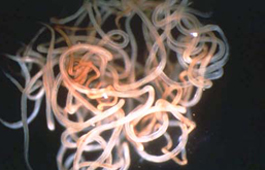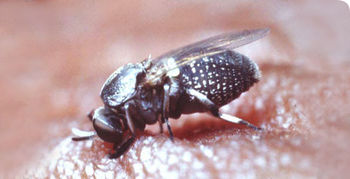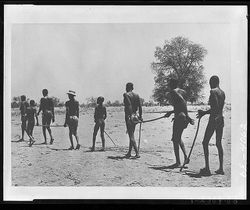Onchocerciasis (Onchocerca volvulus): Difference between revisions
From MicrobeWiki, the student-edited microbiology resource
No edit summary |
No edit summary |
||
| Line 1: | Line 1: | ||
[[Category:Pages edited by students of Tyrrell Conway at the University of Oklahoma]][[Image:OULOGOBIANCO.JPEG|thumb| | [[Category:Pages edited by students of Tyrrell Conway at the University of Oklahoma]][[Image:OULOGOBIANCO.JPEG|thumb|400px|right|University of Oklahoma Study Abroad Microbiology in Arezzo, Italy[http://cas.ou.edu/study-abroad/]]] [[File:Adultvolvulus.jpeg|320px|thumb|left|Picture of Adult [[Onchocerca volvulus]] worms from the World Health Organization. http://www.who.int/apoc/media/adult_worms.JPG ]] | ||
==Etiology/Bacteriology== | |||
===Taxonomy=== | ===Taxonomy=== | ||
| Domain = [[Animalia]] | | Domain = [[Animalia]] | ||
| Line 15: | Line 14: | ||
==Pathogenesis== | ==Pathogenesis== | ||
===Transmission=== | |||
[[File:FeedingSimuliumFly.jpeg|350px|thumb|left|A known vector of [[Onchocerca volvulus]] the Simulium Blackfly feeds on a human. Courtesy of WHO via the Natural History Museum. http://www.nhm.ac.uk/nature-online/species-of-the-day/scientific-advances/disease/simulium-yahense/index.html ]] | [[File:FeedingSimuliumFly.jpeg|350px|thumb|left|A known vector of [[Onchocerca volvulus]] the Simulium Blackfly feeds on a human. Courtesy of WHO via the Natural History Museum. http://www.nhm.ac.uk/nature-online/species-of-the-day/scientific-advances/disease/simulium-yahense/index.html ]] | ||
===Infectious Dose, Incubation=== | |||
===Virulent Factors=== | |||
==Clinical Features== | ==Clinical Features== | ||
===Symptoms=== | |||
===Morbidity/Mortality=== | |||
==Diagnosis== | ==Diagnosis== | ||
==Treatment== | ==Treatment== | ||
===Traditional=== | |||
===Merck=== | |||
==Prevention== | ==Prevention== | ||
[[File:Walkingblind.jpeg|250px|thumb|right center|Children lead men affected by Onchocerciasis. Published in the Atlas of Tropical and Extraordinary Diseases via the National Museum of Health and Medicine. https://www.flickr.com/photos/medicalmuseum/3969963699/in/album-72157622366709345/]] | [[File:Walkingblind.jpeg|250px|thumb|right center|Children lead men affected by Onchocerciasis. Published in the Atlas of Tropical and Extraordinary Diseases via the National Museum of Health and Medicine. https://www.flickr.com/photos/medicalmuseum/3969963699/in/album-72157622366709345/]] | ||
==Host Immune Response== | ==Host Immune Response== | ||
==References== | ==References== | ||
Revision as of 13:39, 26 July 2015

University of Oklahoma Study Abroad Microbiology in Arezzo, Italy[1]

Picture of Adult Onchocerca volvulus worms from the World Health Organization. http://www.who.int/apoc/media/adult_worms.JPG
Etiology/Bacteriology
Taxonomy
| Domain = Animalia | Phylum = Nematoda | Class = Secernentea | Order = Spirurida | Family = Onchocecidae | Genus = Onchocerca | species = O. volvulus
Description
Pathogenesis
Transmission

A known vector of Onchocerca volvulus the Simulium Blackfly feeds on a human. Courtesy of WHO via the Natural History Museum. http://www.nhm.ac.uk/nature-online/species-of-the-day/scientific-advances/disease/simulium-yahense/index.html
Infectious Dose, Incubation
Virulent Factors
Clinical Features
Symptoms
Morbidity/Mortality
Diagnosis
Treatment
Traditional
Merck
Prevention

Children lead men affected by Onchocerciasis. Published in the Atlas of Tropical and Extraordinary Diseases via the National Museum of Health and Medicine. https://www.flickr.com/photos/medicalmuseum/3969963699/in/album-72157622366709345/
